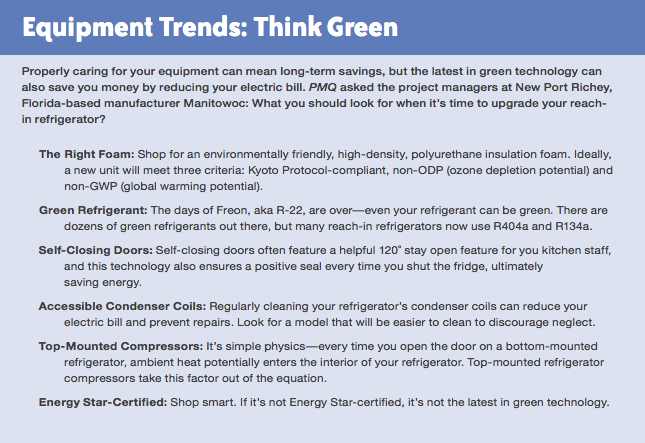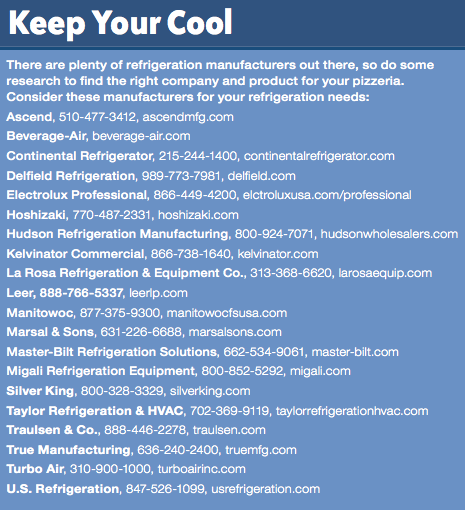
In the pizza industry—where the holy trinity consists of dough, sauce and cheese—you almost always need to chill your ingredients before you char them. This means your refrigerators are major kitchen assets—ranking right up there with your oven when it comes to appliances that require daily use. If you’re a high-volume operator and use distributors for the majority of your ingredients, you likely depend on a walk-in unit for safe storage. But reach-in, pass-through and prep table refrigerators also outfit both big chain and mom-and-pop pizzeria kitchens. They’re tools that help your kitchen crew quickly reach the ingredients they need and, like all tools, need to be taken care of for maximum longevity. Investing money and maintenance hours in the right equipment is a must for ensuring your food is stored safely between 38˚ and 40˚F, saving money long-term, preventing food waste, and maximizing back-of-the-house efficiency for front-of-the-house satisfaction.
PMQ asked manufacturers how operators can maintain their refrigerators’ capabilities and establish practices for getting the longest operating life out of their equipment.
Clean Condensers
You and your staff likely spend a great amount of time making, tossing and stretching dough, which generates a lot of particles floating around in the air—one of your refrigerator’s biggest enemies. When a refrigerator’s condenser gets dirty, the compressor has to work harder to maintain temperatures. As a result, your equipment uses more electricity, which can cause your compressor to overheat. What’s worse, when an unattended refrigerator stops working, it’s only a matter of time before your inventory goes bad, and suddenly you’re losing money in sales and inventory, too.
On the other hand, by cleaning your machine before closing every night, your refrigerated appliances can last more than 20 years without requiring major repair. This duty should ideally fall upon your closing staff, says Clint Royster, national sales manager for U.S. Refrigeration in Beltsville, Maryland. “Maintenance needs to be high on your priority list,“ he points out. “You can easily increase the life of your refrigerator by 50%.”
Royster points out that you should consult your user manual for recommended maintenance practices. If you’re buying a new unit, some manufacturers now utilize smartphone technology, placing QR codes on refrigeration units so you can obtain a Web-based manual on your mobile device. Regardless of how you review the manual, make sure your employees read it, too, so they learn the proper maintenance for your individual units.

Stay Sealed
On any refrigerator, preserving the integrity of the door’s seal is also important; an airtight seal makes your unit more energy-efficient. After cleaning your compressor regularly, take the time to clean and inspect your refrigerator door gaskets for cracking, because seals are often overlooked by operators, notes Randy Augustine, senior product manager for Hoshizaki in Peachtree City, Georgia. “Your door gasket needs to be clean, pliable and lubricated,” he explains. “Taking care of your gaskets is probably the most neglected duty when it comes to long-term maintenance. It’s also one of the least expensive ways to maintain your equipment.”
You should look for additional features in a refrigerator that promote savings, says Faith Bamka, marketing manager for Continental Refrigerator in Bensalem, Pennsylvania. Search for LED lighting to lower your power bill; check for Energy Star features, such as anti-sweat controls and thicker walls, which hold temperatures longer. Some of the latest glass-door refrigerators can hold temperatures nearly as well as thicker door models and can reduce the amount of time your fridge is open when you’re searching for ingredients.
Professional Help
Regular checkups for your refrigeration may seem unnecessary in the short term, but they can help extend the life of your equipment. On most new purchases, you’ll likely have a parts replacement warranty for six months to two years. However, you should also ask about service contracts; as Joe Ferrara, president of Lindenhurst, New York-based Marsal & Sons points out, this option will keep knowledgeable eyes on your equipment in the first years of operation. If your manufacturer can’t recommend a maintenance professional, ask a noncompeting operator for advice. If your equipment is older, you should have a refrigeration professional examine the unit at least once per year for reach-in refrigerators and twice per year for refrigerated prep tables. However, Augustine recommends three Properly caring for your equipment can mean long-term savings, but the latest in green technology can also save you money by reducing your electric bill. PMQ asked the project managers at New Port Richey, Florida-based manufacturer Manitowoc: What you should look for when it’s time to upgrade your reach-in refrigerator? The Right Foam: Shop for an environmentally friendly, high-density, polyurethane insulation foam. Ideally, a new unit will meet three criteria: Kyoto Protocol-compliant, non-ODP (ozone depletion potential) and non-GWP (global warming potential). Green Refrigerant: The days of Freon, aka R-22, are over—even your refrigerant can be green. There are dozens of green refrigerants out there, but many reach-in refrigerators now use R404a and R134a. Self-Closing Doors: Self-closing doors often feature a helpful 120˚ stay open feature for you kitchen staff, and this technology also ensures a positive seal every time you shut the fridge, ultimately saving energy.
 Accessible Condenser Coils: Regularly cleaning your refrigerator’s condenser coils can reduce your electric bill and prevent repairs. Look for a model that will be easier to clean to discourage neglect. Top-Mounted Compressors: It’s simple physics—every time you open the door on a bottom-mounted refrigerator, ambient heat potentially enters the interior of your refrigerator. Top-mounted refrigerator compressors take this factor out of the equation. Energy Star-Certified: Shop smart. If it’s not Energy Star-certified, it’s not the latest in green technology. Equipment Trends: Think Green maintenance visits per year for refrigerators in kitchens with a lot of flour flying through the air. Ultimately, you should regularly observe your refrigerators and call in a professional if your machine is running noticeably louder than normal, not holding temperature, or not holding uniform temperature in all parts of the interior. If think you can maintain your own equipment, contact your manufacturer about extendable warranty options for backup.
Accessible Condenser Coils: Regularly cleaning your refrigerator’s condenser coils can reduce your electric bill and prevent repairs. Look for a model that will be easier to clean to discourage neglect. Top-Mounted Compressors: It’s simple physics—every time you open the door on a bottom-mounted refrigerator, ambient heat potentially enters the interior of your refrigerator. Top-mounted refrigerator compressors take this factor out of the equation. Energy Star-Certified: Shop smart. If it’s not Energy Star-certified, it’s not the latest in green technology. Equipment Trends: Think Green maintenance visits per year for refrigerators in kitchens with a lot of flour flying through the air. Ultimately, you should regularly observe your refrigerators and call in a professional if your machine is running noticeably louder than normal, not holding temperature, or not holding uniform temperature in all parts of the interior. If think you can maintain your own equipment, contact your manufacturer about extendable warranty options for backup.
When it comes to long-living kitchen equipment, preventative actions are obviously preferable to constant repairs later on. Operators should remember that this effort is a management and mechanical issue, so educate your managers and workers on essential maintenance and cleaning practices. It’s easy to go days and even weeks without taking the extra time to clean your condensers, inspect seals and wipe away flour that falls inside and outside your machine. But with the right disciplined approach, you’ll be on track to save money over time rather than spend it all when your refrigerator
unexpectedly fails.














